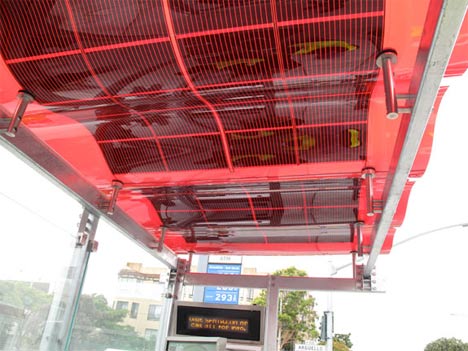What a delightful combination for environmentalists! While you are waiting for your bus to arrive you can happily stay in touch with the cyber world. San Francisco bus stops produce solar electricity and offer Wi-Fi connectivity too. By 2013, San Francisco is planning to have 1100 such solar-powered bus shelters put in throughout the city. This project can act as a catalyst for other states and even countries to follow. They have taken care of the bus stops at the grass root level too. They have used recycled materials to develop these bus stops. The bus stops’ roofs will have solar panels. The underutilized energy of these bus shelters will be directed back to the grids.

The shelter will capture the solar energy with a rolling red top of photovoltaic panels to power the LEDs, the Wi-Fi routers and the intercom. Once all the 1100 shelters are installed and functional these routers will provide Wi-Fi connectivity, probably throughout the state.
San Francisco Mayor Gavin Newsom recently inaugurated the first solar powered bus shelters designed by Lundberg Design. This solar bus stop is situated at Geary and Arguello boulevards in the Richmond District. This new bus shelter boasts of an undulating solar roof that resembles both the hills of San Francisco and a seismic wave. San Francisco falls in the seismic zone. 40% post-industrial recycled polycarbonate material is used in the construction of the roof. In between thin-film photovoltaic cells are embedded. The steel used in the bus shelter is of 75% recycled material. Another advantage of using the recycled material is the reduction in maintenance cost. These materials will not be graffiti and etching friendly. “We’re going to see a very stringent maintenance schedule adopted and implemented,” Newsom opined. “I’m looking forward to seeing this shelter looking like this four, five, ten years from now. I’ll be driving by — and riding by, because little do you know I take Muni in spite of some of those who wish I didn’t so they’d have another reason to criticize me.”
The shelter also features a pushbutton update system, more room for transit information, and is expected to feed the energy into the city’s electrical grid.
Though the site of the first shelter is in the foggiest parts of town, but it definitely proclaims to have a clear vision and set great standard for things to come. The current color is ruby red but they will soon utilize amber as more shelters are installed along Market Street and throughout San Francisco. Mayor Newsom proudly proclaimed: “Transit shelters that use photovoltaics, LEDS, and WiFi are going to be standard in the future and I’m proud that San Francisco is once again acting like the pace car for other cities by trying and implementing these technologies.”
The polycarbonate roof structure was designed by 3form Materials Solutions. The photovoltaic laminates were provided by Konarka Power Plastic. None of the two companies had any experience in implanting photovoltaic cells into a polycarbonate base. But they had developed a technology that realizes negligible electricity loss, and subsequently patented the process.
The MTA and Clear Channel didn’t go for a predesigned solution. They held a design competition and selected a local architect, Olle Lundberg of Lundberg Design. Olle Lundberg confirmed that this was his first civic project. His firm designed and constructed restaurants.
“It’s been fun to leave your signature on the city,” said Lundberg. “We’ve done some really beautiful buildings in the city, but honestly nothing will have the same impact as [1100] of these will. These are going to be everywhere and are going to be this kind of icon. I do hope that they become part of the street vocabulary of San Francisco.”
 Follow
Follow